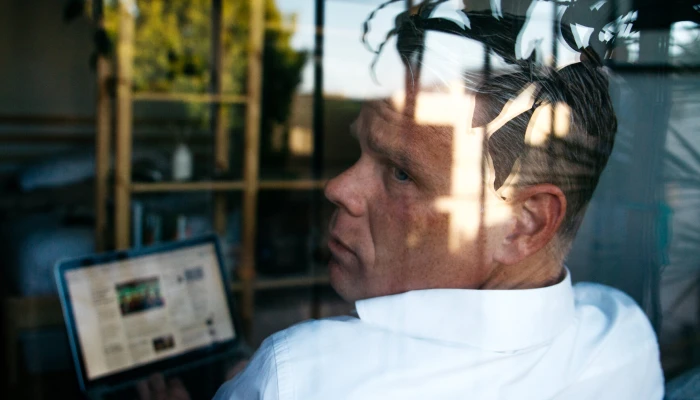Life after languishing: tips to get through the pandemic’s next phase
If you’ve been in a hybrid-work holding pattern, amid dealing with restrictions to your movements and social connections, you’re probably feeling the fatigue of living out a groundhog day repetitiveness – even more so where you’ve had to balance both work and family commitments under the one roof.
For those of us in these situations, inevitably our work satisfaction and performance, home life, family commitments and personal wellbeing have all sustained impacts to varying degrees.
Yes, we might have done well to stay on top of all the practical, logistical challenges, but how easy it’s been to overlook the underlying challenges to our mental health along the way, something many of us are beginning to catch onto only now. Unaddressed over time, pressures like this can run us to the ground and leave us feeling and functioning poorly.
There’s a name for this experience: it’s called languishing. Languishing is a state of low mental wellbeing, without necessarily exhibiting the symptoms of mental ill-health.1 It’s essentially about unproductive emotions. People who are languishing describe themselves as having no excitement, joy or motivation about anything. Life feels stagnant, directionless and empty. When it comes to work, they have trouble concentrating and are not able to function at their full capacity. Languishing is the opposite of flourishing, which is when we’re living and performing at optimum levels, close to our full potential.
During the pandemic, many of us haven’t been able to set or achieve goals that are meaningful, like travelling, socialising with others or attending events that mark milestones. Without these goals, we do not feel like we are making progress, which can negatively affect our mood and mindset.2 This is coupled with an underlying anxiousness due to the ongoing uncertainty and belief that we have very little control over what happens next, ultimately leaving us languishing. Burnout is an example of this.
Recovery in a post-pandemic world isn’t as instant or easy as people may think; there are challenges people will likely face.
What the new challenges might look like
In Australia, with the promise of significant changes around the corner particularly for the eastern states, while there may be some relief to look forward to, there may understandably be some nerves and anxiety in relation to what the new reality might look like; what new settings and scenarios might be thrown our way, specifically in terms of how we balance work and life.
Once the 70 to 80 percent vaccination targets are reached, the focus will turn to how we navigate changes in our work environment and reshuffle our family and personal-life responsibilities accordingly. There will be an expectation on us to bounce back post-pandemic, despite those of us still healing from the trauma of the past 19 months.
Recovery in a post-pandemic world isn’t as instant or easy as people may think; there are challenges people will likely face. The Mental Health Foundation of Australia recognises this and has focused October 2021’s Mental Health Month on preparing for such challenges.
Some of these next-phase challenges might include:
- grappling with lowered mental health or experiencing a new diagnosis of mental ill-health, which would colour your ability to re-enter society while functioning optimally at work and life
- for those living with family, grieving the loss of the time you had with your family during lockdown, e.g. as your kids settle into their school and social routines, and you go back to spending more than 24 hours of your week away from home
- constantly thinking or worrying about your kids, partners or family because you are no longer around them all the time
- feeling overwhelmed when taking up all the aspects of life that dropped off during the pandemic, like family obligations, reincluding a gym routine, fitting in travel plans, chauffeuring your kids to their extra-curricular activities, and travelling for work (you may need to reshuffle your work arrangements to do these things and the thought of bringing this up to your supervisor may be stressful)
- physical and mental exhaustion being at the office five days a week, having been out of practice for so long, which in turn can affect how you feel and act around your loved ones at home
- anxiety in cases where the workplace is perceived as lax in complying with public health precautions (e.g. colleagues neglecting social distancing when reuniting or getting comfortable again with each other, slow adoption of new restrictions if a new variant emerges or cases increase).
How can we work towards flourishing in the next phase?
There are some strategies to help you cope, and maybe even flourish during these tumultuous times, based on two settings you may find yourself in.
While working from home
-
Take some time to establish (or re-establish) your boundaries
Start by writing out your life commitments. Maybe you need to look after your children while your partner does some deep work on Wednesday after 3pm. From there, create your boundaries. In this scenario, ‘no additional non-urgent tasks after 3pm on Wednesday’ might be a good boundary to establish.To assist you in sticking to your boundaries, it may also help to develop a practice to stop and think for five minutes before saying ‘yes’ to any task outside your job responsibilities.
-
Ask for help when needed, while being considerate of your colleagues
Don’t be afraid to ask for help from your colleagues if you need assistance with certain tasks, but do so while being mindful of their boundaries and capacity. When asking for help, think about what you can do to help make the task as easy as possible for your colleague to complete without adding stress to them. -
Make room to be in an uninterrupted flow state
The flow state is also known as ‘being in the zone’. It is when your juices are flowing and doing the work doesn’t feel like a slog. 3,4A major disruption to the flow state is distractions. To combat this, try to carve out one to two hours a day of uninterrupted time so you can achieve flow at work. You may like to try one of the strategies below to see if it’ll work for your circumstances:
- schedule your deep work to take place during your child’s first two school periods, as they may find it easier to focus and stay engaged in morning classes
- enlist help from a babysitter if you can, even if just for two to three hours during your peak productivity hours
- set your older kids up with where the food is so they can help themselves during their breaks
- silence your emails and social media for that set period create a mental cue or ritual, like a candle, instrumental music, diffuser or cup of tea, to signal to your brain that it’s time to get in the zone
- choose just one big task to focus on at any time instead of multitasking
- if you know that you have certain tasks on your non-work to-do list that will niggle at you for the rest of the day, do these tasks the night before or early in the morning before work.
Transitioning to the post-vaccine work environment
-
Talk about what you are concerned about with the people you’re living with
Discuss how you will work with one another to ensure each person is supported to flourish in their work and life. You may want to discuss this with a mental health professional if you need extra support to manage your anxieties and feelings of overwhelm. Talking about your concerns with others and making plans for how to overcome them brings awareness to what kind of boundaries you want to set as you move into a post-pandemic work situation. -
Write down exactly what was great about working from home and see if these can be brought into the future
If you don’t want to lose some of the positive things that came out of remote working, like flexibility or less commuting, list them and note down the specific reasons why you identified these as things that went well. Then, create an action plan for what you need to do to make the post-pandemic work arrangement good for you. Some of the actions may be something you can achieve on your own, like choosing a less intensive way of commuting, but some may warrant a discussion with your supervisor.5 -
Communicate your thoughts with your employer
Start making plans for how to bring up your concerns or ideas about work arrangements post-pandemic with your supervisor. Aim to have the conversation sooner rather than later, so that they get the opportunity to learn what their team members need to be able to perform well, and consider these while arranging post-vaccine work conditions. -
Team leaders need to remain as supportive as they were when the pandemic first hit
If you are a team leader or supervisor, do all you can to continue prioritising employee satisfaction and wellbeing. Remembering that post-pandemic recovery isn’t without its challenges, it is still important to demonstrate empathetic support for staff without leaving any staff behind or feeling unheard.It may mean putting more emphasis on monitoring each team member’s workload and carving out time during work hours to discuss their concerns. It may mean pre-empting the issues that may crop up for them and considering solutions the company can offer that will actually address these challenges for your team members.
En Masse offers a number of relevant workshops in this area designed to promote flourishing in your team, including Flexible minds for a flexible workforce, Mental health in uncertain times and Burnout busters: restoring team energy. Talk to us today about a webinar or series of sessions targeted to your audience.
References
- Keyes CL. The mental health continuum: from languishing to flourishing in life. J Health Soc Behav. 2002;43(2):207-222.
- University of New England. Between depression and flourishing, there’s ‘languishing’. University of New England, 2021. Available from: Between depression and flourishing, there's 'languishing' - University of New England (UNE)
- Souders B. Flow at Work: The Science of Engagement and Optimal Performance. Positive Psychology, 2020. Available from: Flow at Work: The Science of Engagement and Optimal Performance (positivepsychology.com)
- Headspace. What is a flow state and what are its benefits? Headspace, 2021. Available from: What Is a Flow State and What Are Its Benefits? - Headspace
- Markman A. Now is the time to design your post-pandemic work life. Fast Company, 2021. Available from: Now is the time to design your post-pandemic work life (fastcompany.com)


